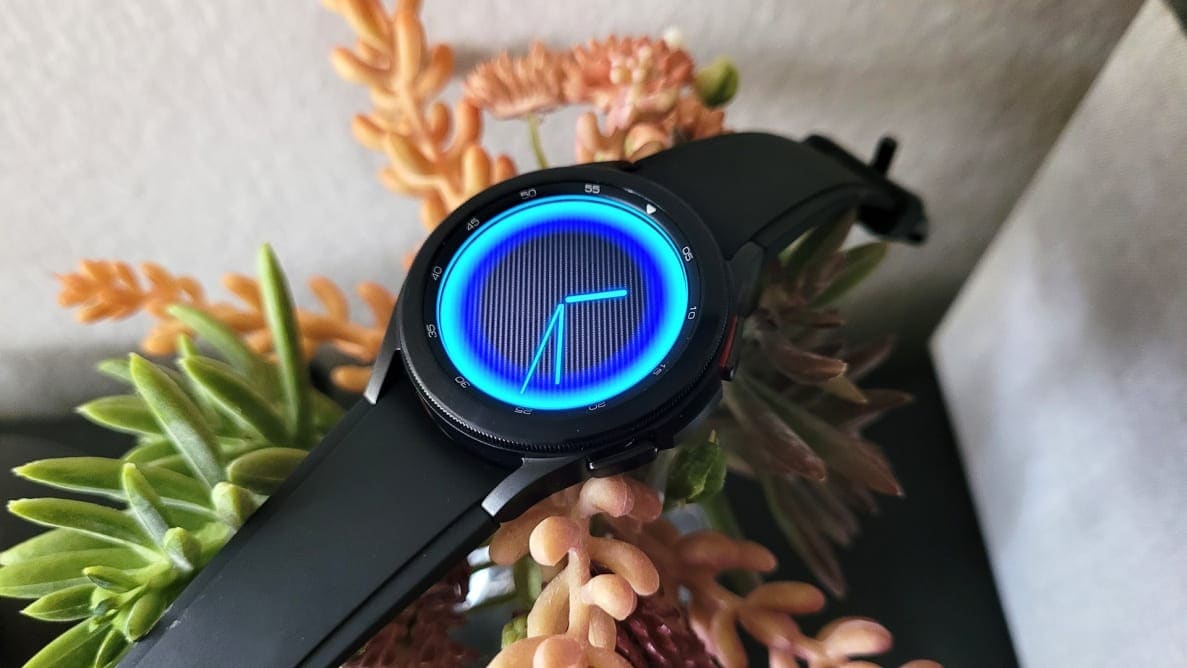Pros
-
Bright, vibrant display
-
Tiles provide a lot of information
-
Solid fitness tracking
Cons
-
No iOS support
-
Bixby needs some work
-
Accessibility feels like an afterthought
Updated November 7, 2022: Samsung's latest Galaxy Watch 4 firmware update appears to be causing issues for some users, including some examples of the device no longer powering on. Those hoping to save some money on this option over the follow-up Galaxy Watch 5 will want to keep this in mind until things have been fixed. We'll update this post when we know more.
If you try to use the Galaxy Watch 4 without a Samsung device, you'll need to adjust expectations. Not only did Samsung remove all support for iOS devices, but non-Samsung Android phone owners will have to download several Samsung apps from the Play Store to get the most out of the Galaxy Watch 4. This new strategy isn’t quite as locked down as Apple’s ecosystem, but it’s clear Samsung is trying to have a larger presence in its users' lives.
About the Galaxy Watch 4 and Galaxy Watch 4 Classic
Note: While this review is mostly focused on the regular Galaxy Watch 4, the vast majority of this review also applies to the Galaxy Watch 4 Classic, with only a few notable exceptions such as the Watch 4’s digital revolving bezel and more sporty design.
- Display: 1.36-AMOLED with 450 x 450 resolution (44mm model) or 1.19-inch AMOLED with 396 x 396 resolution (40mm model)
- Processor: Exynos W920 Dual Core 1.18GHz
- Navigation: NFC, A-GPS, GLONASS, Beidou, Galileo
- Connectivity: LTE, Bluetooth® 5.0, Wi-Fi 802.11 a/b/g/n 2.4+5GHz
- Sensors: Accelerometer, Barometer, Gyro Sensor, Geomagnetic Sensor, Light Sensor, Optical Heart Rate Sensor, Electrical heart sensor, Bioelectrical Impedance Analysis Sensor
- Water resistance: Up to 50 meters (5 ATM)
- Audio: Microphone and speaker
- Battery: 361mAh (44mm)/247mAh (40mm), multi-day battery
- Memory and Storage: 1.5GB RAM + 16GB Internal Memory
- Extras: Samsung Pay
The Galaxy Watch 4’s interface is bolder and more colorful than Samsung's previous Tizen systems, which adds more pop and character to the whole experience. Samsung’s partnership with Google also brings efficient battery life to the Galaxy Watch 4, as it can easily last a day or longer with light usage without needing a charge halfway through. While the battery lasted up to a few days when we tested it for our Galaxy Watch 3 review, other users have reported needing to charge the battery after 24 hours, so results may vary greatly by usage.
If you liked the Galaxy Watch 3’s bezel, you may prefer the Galaxy Watch 4 Classic to the regular version. It starts at $350 ($100 more than the Watch 4’s $250 starting price) and has a rotating dial wrapped around its display, which lets you navigate through menus and widgets without having to touch the screen. The regular Galaxy Watch 4 uses a virtual dial on the bezel.
What we like
Vibrant and bright display
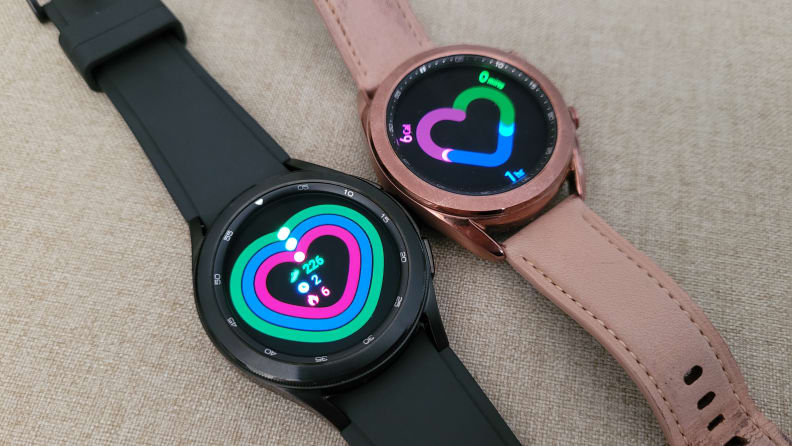
The Galaxy Watch4 Classic (left) has a rotating bezel like the Galaxy Watch3 (right) that makes it easy to navigate through the watch's interface.
If you like to use your smartwatch while catching a few rays outside, you'll be in good hands with both the Galaxy Watch 4 and Watch 4 Classic. Both the 40mm and 44mm models come with an AMOLED display that's bright and colorful, even with the sun shining down on it.
During cycling workouts, serving up aces on the tennis court, or walking around town, both displays showed up clearly enough to present the workout's duration, distance, and average speed without making you squint. If the display is too dim, you can adjust the brightness with a quick swipe down from the top to access the quick settings pane.
Information at a glance with Tiles
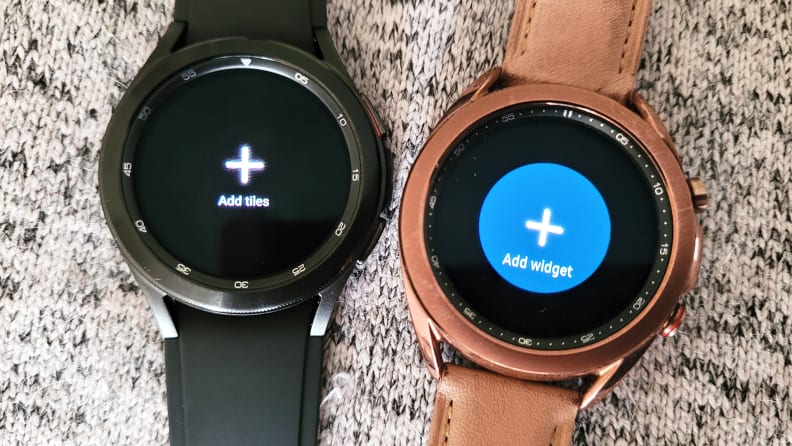
Widgets from the Galaxy Watch3 (right) were renamed to Tiles on the Galaxy Watch4 (left).
A good smartwatch does more than present the time on a flashy, custom display. It should make the most important information on your phone available on your wrist. The Galaxy Watch 4’s Tiles—formerly called Widgets on the Watch 3— make checking features like the weather, upcoming appointments, your stress level, or starting a specific workout easy to sift through.
WearOS 3's Tile interface, a carry-over from Samsung's Tizen system, lives to the right of the watch face, and you can access the Tiles by swiping on the virtual or tactile bezel (depending on which watch you have) surrounding the screen. Alternatively, you can swipe left through each widget to get what you need. Once you're ready to get back to your watch face, simply press the Home button (the button with the red band around it). You can customize which Tiles you see on your watch, too, from either the watch itself or from the Samsung Galaxy app on your phone.
Our one complaint is that, as touched on above, the Watch 4's virtual bezel (as opposed to the tactile one on the Classic) is a bit finicky. There’s a learning curve to figuring out exactly where to place your finger and how to activate the scrolling. Once you’ve gotten the hang of it, though, the digital bezel works well and the haptic feedback does a good job of indicating movement.
Fitness tracking is ripe with features ...
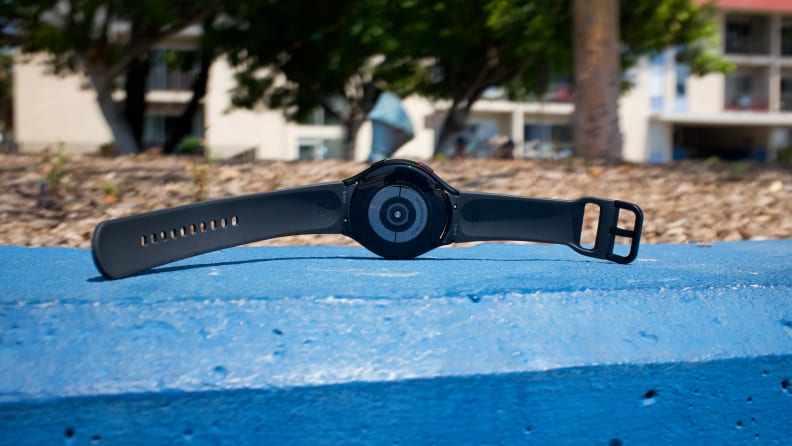
The Galaxy Watch 4 is packed with sensors to track all kinds of health metrics, including new body fat and skeletal muscle measurements.
If you're hoping to use your smartwatch as your main fitness tracker, both the Galaxy Watch 4 and Watch 4 Classic have plenty for you to work with. You can do the same things you can do on the last-gen Galaxy Watch like track your sleep, count your daily steps, or get the nitty-gritty details of how your body holds up during an intense workout, all without having to tweak too many settings.
But there are also some new features on the Watch 4, like a bioelectric impedance sensor, which sends a tiny electrical current through your body to check several body composition stats. It takes about a minute to get the reading, which includes estimates of your body fat and skeletal muscle percentages, Body Mass Index (BMI), fat mass, body water, and basal metabolic rate (BMR). However, these numbers are better suited for your own tracking than for any in-depth analysis, as they rely on you manually entering your weight so the Watch 4 can do the calculations.
It’s important to note that if you have a pacemaker or any other internal medical device, you should not use this tool as the electrical current can affect those types of devices.
In addition to seeing your body composition data from your Galaxy Watch 4 and Samsung Health app, you can also see your daily steps, time spent active, calories consumed and burned, average heart rate, stress level, and much more. The app on your phone will have more comprehensive information in the form of charts, but what you get on the watch is a good summary if you need to take a peek while you're mid-workout, or if you left your phone behind.
You can also view stats like your daily steps and calories burned directly from a tile, and you can even set up watch faces that display health info right on your watch's home screen. Samsung's at-a-glance activity monitor now mimics Apple's ring interface, too. It swapped the tri-color heart from the Watch 3 to three heart rings of different colors, along with showing you your current beats per minute (BPM) and daily steps below the watch hands, and another with a shortcut to quickly start a workout without having to swipe into your Tiles.
... and plenty accurate, too
We found that everything that gets tracked from the Watch 4 is quite accurate compared to the competition. In a side-by-side comparison with the Apple Watch 5, the Galaxy Watch 4's workout tracking produced results that closely resembled what we found on Apple's watch using the app Cyclemeter. Over a nearly five-mile ride, the Apple watch logged 4.43 miles while the Galaxy watch logged 4.13 miles. The Apple watch also recorded a max speed of 9.9 mph compared to the Galaxy watch's 9.88 mph, and a total caloric burn of 222 calories versus 210 calories.
In a side-by-side comparison with the Galaxy Watch 3, the Watch 4's results were comparable, if not improved. During a 30-minute elliptical workout, the Watch 4 logged 234 calories burned with an average BPM of 146, while the Watch 3 logged 206 calories with an average BPM of 143. During a 15-minute weight-training workout, the Watch 4 estimated a total of 83 burned calories, while the Watch 3 guessed 89. It's important to note that these readings are all estimates, and may not be 100% accurate, but based on these results, we believe the Watch 4 has a slight leg up over the Watch 3.
The Watch 4 also successfully paused the workout after a maximum of thirty seconds after we reached a stop sign or had to take a break, and quickly resumed once it noticed motion again. The Galaxy Watch 3 does the same thing, but it takes longer for it to recognize when you start and stop a workout.
What we don't like
All Samsung, all the time
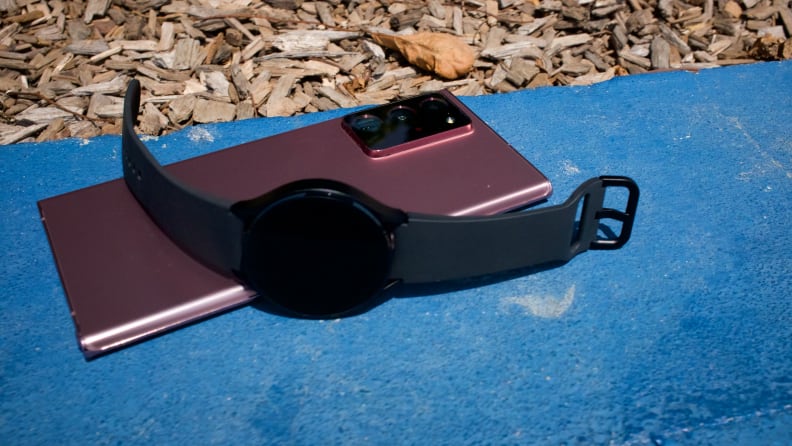
Even though the Galaxy Watch4 is great, an accompanying Samsung Phone is basically a requirement.
One of the best features about the previous Galaxy Watches is they were somewhat device agnostic, working with Android or iOS. Not only is that no longer the case (iPhones are out), but Samsung has also aimed this watch directly at Samsung owners.
Although the Galaxy Watch 4 works with any phone running Android 6 or above, using it without a Samsung phone requires jumping through a few hoops. You still need Samsung's Wearable and Health apps to set up your Galaxy Watch, and there's no support for Google Pay so you'll need a Samsung Pay account. You'll also need the Galaxy Store app if you want to download more watch faces.
No Google Assistant
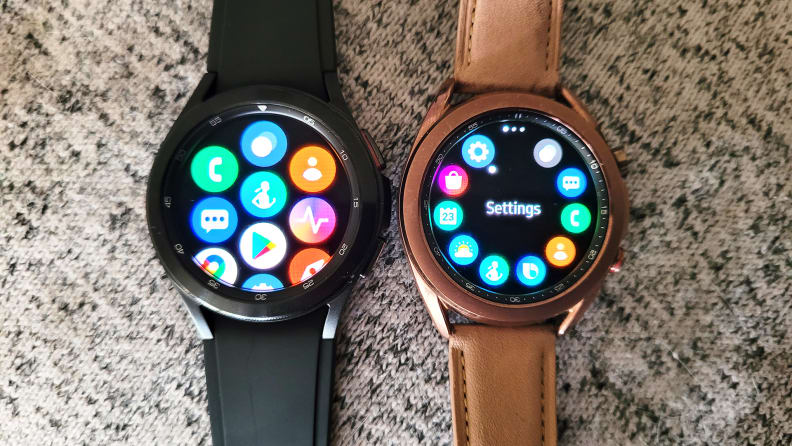
One of the biggest user interface changes between the Galaxy Watch3 (right) and the Galaxy Watch4 (left) was to the app panel.
One of the most frustrating omissions from Google and Samsung's new partnership is that there's still no option to use Google Assistant in place of Samsung’s virtual assistant, Bixby. If you plan to use a voice assistant only for basic tasks, this may not feel like a huge deal. Bixby makes it easy to set timers, add a task to your list, read your messages, check your schedule, or calculate tip percentages.
But if you were hoping to take on more nuanced tasks like, say, chatting with your voice assistant to accomplish menial goals or answer trivial questions, you should temper your expectations for the Galaxy Watch 4.
With Bixby, you can't do basic Google Assistant tasks like setting multiple timers (starting a timer while another one is running will kill the current timer), which can be a hindrance when you're doing things like cooking complex dishes and need a few reminders to prevent anything from burning. You also can't ask questions that might come up in conversation with a friend, like "How old is Bruce Willis," and you can't summon Maps navigation from the watch, despite Google Maps being installed, both of which are options using Siri on the Apple Watch.
Also, to talk to Bixby, you have to hold down the top button on the Galaxy Watch 4 the entire time you're speaking. This comes down to personal preference, but it’s annoying when other watches simply require you to hold down a button long enough to trigger the voice assistant, then allow you to let go as you continue talking.
Accessibility feels like an afterthought
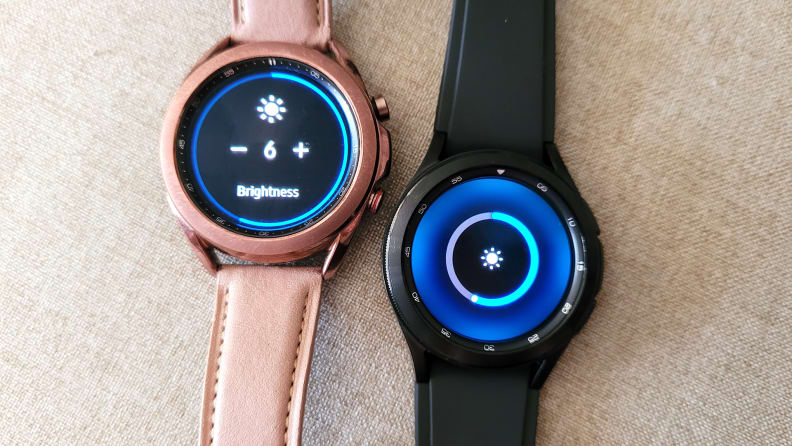
Samsung removed the brightness and volume control numbers on its Galaxy Watch4 (right) in favor of a plain, round dial.
The Galaxy Watch 4 has several accessibility options: a screen reader (now called TalkBack), visibility enhancements, and hearing enhancements are all available to tinker with as you need.
The existence of these features shows some mindfulness to those who have specific accessibility needs, but some of the execution feels lackluster. For example, you can toggle the speed of the watch's text-to-speech engine, but anything beyond roughly 25% speed sounds almost incomprehensible, and once you get to the fastest setting it all sounds like gibberish. In contrast, the Galaxy Watch 3's speech rate is much more gradual, with the fastest setting still comprehensible.
If you go into TalkBack settings, you'll notice an interface shift with a thinner, smaller font that's harder to read than the fonts populating the rest of Wear OS 3. TalkBack isn’t as easy to disable as it is to turn on, though. Once you’ve enabled the screen reader, you have to use two fingers to perform actions like clicking or swiping, since single-finger taps in TalkBack simply tell the Watch which screen elements to dictate back to you. This would be fine on a larger screen, but on a small watch display, it’s hard to get all the gestures and taps just right.
It's nice to know these features are there for those who need them, but a little extra thought and care could have ensured that these features aren't just available, but easy to use as well. Wear OS is, overall, intuitive and easy to get the hang of, but it would have been nice to see that extend to all the accessibility features.
Should you buy it?
Yes, as long as you own an Android (and preferably Samsung) phone
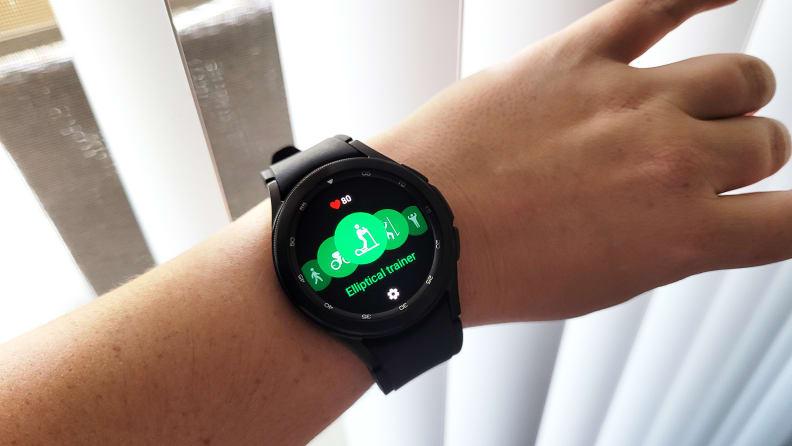
The workout options on the Galaxy Watch4 now appear in a rotating carousel rather than a list on the Galaxy Watch3.
If you've already bought a Samsung smartphone, or you intend to make the switch, the Galaxy Watch 4 is a delightful smartwatch that works as well for notification triage as it does for staying on top of your health metrics. Its display is bright even in direct sunlight, and its battery can easily get through a day's worth of usage, though you should charge before bed if you plan on doing any sleep tracking.
Nearly everything about the Galaxy Watch 4 is great, as long as you've paired it with a Samsung phone. Otherwise, you'll have to install a bunch of Samsung's apps to get the full experience—and even then certain Tiles for other Samsung devices like the Galaxy Buds are only useful if you actually own the earbuds. That said, the Galaxy Watch 3 can do nearly everything the Watch 4 can, and we prefer its tactile dial on the Classic over the virtual bezel, so you may not need to upgrade if last year’s model still suits your needs.
If you have an iPhone, you're also out of luck as the Galaxy Watch 4 is not compatible with iOS. That said, if you're planning on staying with iPhone, you'd probably be better off with an Apple Watch, anyway.
There’s plenty to love about the Galaxy Watch 4. It’s the best smartwatch to pair with Samsung phones, and arguably for other Android phones too at the moment. If you’re willing to jump through the hoops of loading up Samsung’s apps on another Android device, the experience is pretty similar to what you’d get on a Samsung device, and that amounts to a pretty excellent smartwatch.
Meet the tester

Jordan McMahon
Staff Writer, Electronics
Jordan has been writing about and reviewing technology since 2017, with products ranging from tablets and apps to fanny packs and home office gear.
Checking our work.
Our team is here to help you buy the best stuff and love what you own. Our writers, editors, and experts obsess over the products we cover to make sure you're confident and satisfied. Have a different opinion about something we recommend? Email us and we'll compare notes.
Shoot us an email

